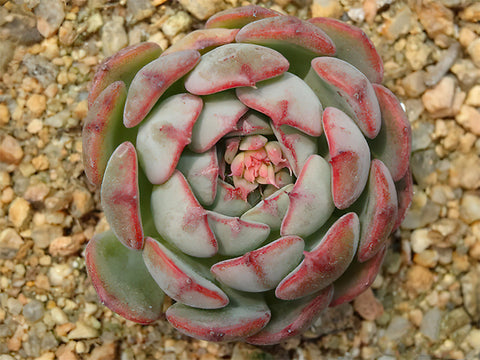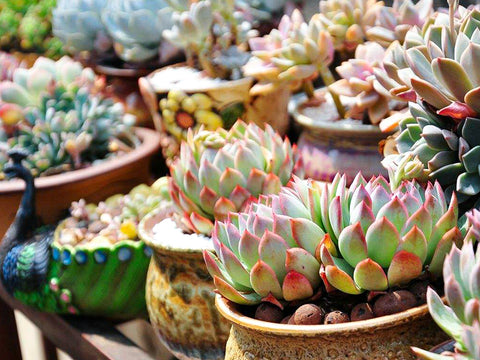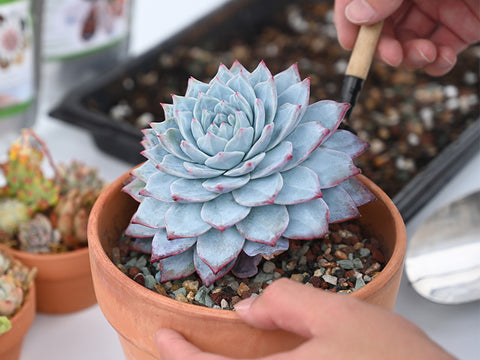Spring is here, and it's time to wake up your succulents! "Hey, babies, it's time to rise and shine!" But waking up succulents isn't as gentle as whispering sweet nothings. Let me share my methods for reviving dormant succulents and preparing them to thrive again.
Why Wake Up Succulents?
If you're new to the succulent world, you might wonder why you must wake them up. Do succulents sleep? Yes, indeed! When temperatures get too hot or cold (usually in summer and winter), succulents slow their growth to conserve energy and adapt to the environment. We call this dormancy; during this time, they may appear dull and stop growing new roots. So, it's essential to wake them up when conditions improve.
You may wonder: What is succulent dormancy?

How to Properly Wake Up Succulents?
Think about how you'd like to be woken up. You wouldn't want to be rudely shouted at, right? Well, succulents feel the same way. Gently wake them up step by step, and they'll grow happily during the growing season!
Time It Right
Timing is crucial when waking up succulents. It's pretty easy to figure out; you can judge by the temperature. When the temperature gradually rises to around 50°F (10°C), it's a good time to wake them up. Most succulents feel comfortable at this temperature, just like basking in the warm sunlight of an early spring morning. Pay close attention to nighttime temperatures too. Keep your succulents indoors to prevent frostbite if it's still around 32°F (0°C) at night.

Offer Them a Drink
During dormancy, succulents have slow root growth and need minimal water. That's why we typically advise against watering them during this period. But imagine waking up feeling thirsty after a long sleep—wouldn't you want a drink? Exactly! Give your succulents a thorough watering. The dormant roots will quickly perk up and grow, eagerly absorbing the water. You'll notice the leaves plump up and regain their glossy appearance.
You may wonder: How to water indoor succulents.
Gradual Exposure to Light
Your succulents have been cozy indoors throughout the winter, basking in warm, gentle sunlight. When spring arrives, abruptly moving them to full outdoor sun can be too harsh, risking sunburn.
What is the right approach? For the first week, place your succulents on a bright indoor windowsill with some ventilation. Then, over the next three weeks, gradually transition them to an outdoor spot with partial shade, receiving only 1-2 hours of direct sunlight daily, with the rest being diffused light. Once your succulents have been acclimated, you can move them to a sunnier spot.

Give Them a Feed
Spring is the perfect time to fertilize your succulents. A bit of fertilizer can help revive dormant succulents and promote fuller growth. Use a slow-release liquid fertilizer formulated for succulents and cacti, diluted according to the instructions. Alternatively, add some organic fertilizers like crushed eggshells or coffee grounds to the soil. Remember not to overdo it, as too much fertilizer can lead to root rot.
You may wonder: How to scientifically fertilize succulents?

Repotting Time
Consider repotting if your succulents have yet to perk up after the first four steps. The roots may have withered during dormancy, so trim away any blackened, rotting roots. After root trimming, let the plant sit in an excellent, shady spot for a few days to allow the wounds to heal before repotting. Your succulent will grow stronger and healthier with a fresh set of roots. Repotting also helps remove fallen leaves from the pot, reducing the risk of bacterial and pest infestations.
Pest Prevention
Spring isn't just a time for plants to become active; it's also when various pests start to stir. Mealybugs, aphids, spider mites, and other pests may target your succulents. Be proactive by removing dead leaves from your succulents' base, cleaning out the pot, and adding systemic insecticides to the soil. Regularly inspect your succulents for signs of pests, and take prompt action if you spot any. Need to know how to get rid of mealybugs? Check out this guide.
Final Thoughts
I use these methods to wake up my dormant succulents, helping them quickly regain their vitality and continue to charm. Don't forget to chant the magic words: "Hey, babies, it's time to rise and shine!" Your succulent babies will indeed feel your anticipation.



























1 thought on “How to Wake Up Dormant Succulents”
Joan Pache
If I may, I have a question about watering. I’ve been in the habit of bottom watering. How do you feel about me adding coffee grounds to the water that the plant will sit in to absorb the water? I don’t overwater but when I do water, I make sure that even the soil on the top has a drink. My collection, which is not a large one, only gets watered when my meter says the soil is dry. I live in Ontario Canada so there is not an opportunity to place any of my succulents or cacti outside. I also only have ~3 hours of sunlight per day. I do have an auxiliary light source which is on ~12 hours a day. If someone would take the time to answer my query, I would really appreciate it.